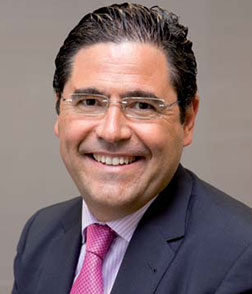Interview with Luis María Sáez de Jáuregui Chairman
Institute of Spanish Actuaries (IAE)
Madrid - EspañaFinancial
Luis María Sáez de Jauregui was born in Madrid on 16 September 1969. He graduated in Economics and Business Studies, specialising in Actuarial Science, from the Complutense University of Madrid, and in Law from the Spanish Distance-Learning University (UNED). He is a practising lawyer and a qualified insurance broker. He began his professional career in January of 1991, when he joined Prudential Insurance Company of America as an actuary. In January of 1994, he moved to ING Nationale Nederlanden, also as an actuary, where he worked until July of 1996. After that, he joined Allianz in Spain to manage the group’s bancassurance subsidiaries (Eurovida and Europensiones), a period he ended as director of the Technical, Actuarial and Legal division. In April of 2008 he took up his current position as director of Life, Pensions and Financial Services at AXA Group in Spain.
In addition to being chairman of the Institute of Spanish Actuaries and a member of its Governing Board, Mr Sáez de Jáuregui is a member of UNESPA’s Life and Pensions Standing Committee and of INVERCO’s Pension Funds Committee. He is also a member of the Spanish Ministry of Finance’s Insurance Advisory Board and of the Ministry of Justice’s Expert Committee responsible for the Road Accident Injury Scale. At the international level, he is a member of the Board of Directors of the International Actuarial Association and of its Financial Risk Committee, Social Security Committee, and Subcommittee on Actuarial Standards. Additionally, he is a member of the Board of Directors of the European Actuarial Advisory Group and of its Standards and Freedoms Committee.
Turning to his teaching activities, he is an associate lecturer at the Carlos III University in Madrid both on the degree and the masters’ Actuarial and Financial Sciences degree programmes. He also teaches on the University of Zaragoza’s MA in Finance, on the Stock Market Studies Institute MA in Risk Management, on PWC’s MA in Actuarial Practice, on UNED’s MA in Financial Advice and Portfolio Management, and on the Savings Banks’ University School’s MA in Insurance. He is a member of the editorial board of the journals Actuarios and Índice. He has written several books and articles in the areas of actuarial science, finance and insurance.




“It is becoming clear that actuaries can help manage a range of financial risks.”
Despite playing a key role in the insurance business, the actuarial profession is largely unknown. This interview contains information, opinions and insight into actuaries and their resilience in the face of the challenges currently arising in the areas of risk, pensions and insurance. According to the IAE chairman, professional actuaries who are passionate about their job have a superb future before them, in Spain and beyond, and regardless of whether their activity is reserved.
When was the Institute of Spanish Actuaries (IAE) created and how many members does it have?
Officially, in 1942. However, the need for accredited actuaries arose earlier, in 1908, when two key statutes were passed in the area of social security and insurance: the law establishing the National Institute of Social Welfare (INP) and the first Law on Insurance. There were no actuaries in Spain at the time, so they were brought in from abroad. Currently, we are one of the four largest institutions in Europe, after the UK’s, which has 7,500 members, Germany’s with 3,500 and France’s with 1,600. We follow with 1,550 members, and next comes the Italian institute with 850 members. Spanish insurance ranks sixth in Europe by premiums, so the size of our membership reflects the industry.
Is access to the actuarial profession the same in every country?
One principle is undisputed at the present time: the actuarial profession is a reserved activity. In other words, the law specifies certain functions that can only be performed by an actuary
No, there are two large categories of countries. One, which includes Spain, is universitycentred. Things are changing in this group as a result of the Bologna process. Any fouryear degree plus a supplementary entrance course allows access to the Actuarial and Financial Sciences master’s programme. The first institution to offer this programme was the Carlos III University in Madrid, and more universities are now joining in. Some European countries have a system based on professional rather than university qualifications. For instance, the actuaries’ institutes in the UK and France organise examinations, assess candidates’ eligibility and issue the required qualifications.
Are Spanish actuaries on a par with those of other European countries in terms of training and performance?
There is always some aspect that Spanish actuaries need to build on. Universities are already working on a number of issues that actuaries will have to address in the near future. The fact of the matter is that Spanish actuaries are, as a rule, on a par with those of any European country. In terms of training, we see this with students moving between different countries under the Erasmus programme. And it is also creating job opportunities. With regard to insurance methods, we also set the standard in some respects. Another example is the fact that some international groups use Spain as an entry platform into Latin America or southern Europe because Spanish actuaries’ profiles favour this.
The actuarial profession today is based on three pillars, which are insurance, pensions and Social Security. In Spain, the Directorate-General for Insurance and Pension Funds constitutes an additional pillar
What does an actuary’s job involve today? What is the situation of the profession now and how is it expected to change?
One principle is undisputed at the present time: the actuarial profession is a reserved activity. This status has not only been preserved over time but has actually been strengthened. In other words, the law specifies certain functions that can only be performed by an actuary. The two main reserved areas are insurance and pension funds and schemes. An actuary’s job involves, for instance, calculating mathematical reserves and technical provisions, which have to bear the actuary’s seal and signature. The form we call 5 GS has to be signed by an actuary.
Does the IAE have a civil liability policy?
Yes, it does. The IAE arranges a policy because, in contrast to other professions, we have unlimited liability. This is a matter we have discussed with the Directorate-General for Insurance and Pension Funds because very few things are unlimited in this world. Our policy is designed to cover liability of up to 1.5 billion euros, and we are currently considering increasing this amount. In a case concerning a pension fund, an actuary was ordered at first instance to pay an exorbitant amount in compensation. At the second instance he was exonerated from paying that sum because it was disproportionate to the remuneration he had received. The Spanish Civil Code requires any damage caused to be compensated, and it is very difficult to establish what the damage will amount to in advance. An actuary acting negligently can cause a huge amount of damage.
Most actuaries work for insurance companies, in the public sector or as risk managers. Businesses are increasingly risk-aware. Does this mean the demand for actuaries has grown?
The actuarial profession today is based on three pillars, which are insurance, pensions and Social Security. But actuaries’ competencies go beyond these fields. Obviously, they are trained to assess financial risks, not just in the insurance sector. In Spain, these three pillars I have mentioned, along with the Directorate- General for Insurance and Pension Funds, take up virtually all actuaries, but this is also the case internationally. For the moment, it is becoming clear that actuaries can help manage a range of financial risks, for instance in banks.
Our policy is designed to cover liability of up to 1.5 billion euros, and we are currently considering increasing this amount
The number of actuaries remains small in some Latin American countries. How is this changing? Which qualifications carry more weight in the profession: European or American?
Indeed, in some Latin American countries the number of actuaries is still quite small, but this is changing. The lack of local professionals often draws actuaries in from Spain and other countries. Many Latin American actuaries were trained in the US and others went to European universities, such as Madrid or Malaga. Ties with Spain are strong, for the simple reason that our common language makes it easier to form relationships. However, each country is different. In Mexico, for instance, many actuaries study in the US on account of its proximity. In any event, we know that the IAE is recognised as an important player. We have many agreements with universities to help them introduce actuarial studies.
Pensions and actuaries
Could pensions be harmonised across Europe?
The EU must first of all continue to make progress towards its own integration and building a solid European Bank. We have seen big failures in monetary union and we have no Eurobonds. There has been talk of tax harmonisation in Europe since 1986 but no headway has been made. Given that this is a key aspect of monetary and banking policy, there is no tax standardisation. Obviously, neither can consensus be reached on retirement because people retire at different ages in each country. The reality is that, as far as state pension systems are concerned, Europe leans more towards divergence than convergence. This includes the actuarial profession. The European directives that are shaping the Solvency II framework do not establish the actuarial profession as a reserved activity, as is now the case in Spanish legislation. Although this is a minor problem, because EU legislation has to be implemented into Spanish statutory law, where these restrictions will continue to apply.
Why is there no coordination at the European level?
Europe is essentially a mishmash. Each country holds on to its customs and traditions. The EU has the power to issue regulations, which apply to everyone equally, but these are more conspicuous by their absence than their presence. We are all familiar with directives, but not regulations. Then we have another important area, namely pension schemes and funds, which are not included in the Solvency Directive but treated as an independent issue. So what is my view on the future of the actuarial role? I think actuaries will continue to exist in Spain. They are one of the reasons why there have not been any great scandals in the insurance business, like we have seen in banking. We have a bad bank but no bad insurer. When I was appointed head of the IAE in February 2012, the IMF representatives came and published a very significant report in June 2012, which took our views on board.
What is your view of the future of the state pension system?
This is an important matter where two words have to be kept very much in mind: pension and supplementary. I will begin with the first one. The word pension comes from Latin and it means a periodical payment, so it cannot be anything else. We have repeatedly heard high-ranking politicians say that pensions are in property. Absolutely not! Savings invested in property should not be mistaken with pensions, which provide periodical payment. The second word is supplementary. If something is supplementary, it is not the main part but an extra that completes the total. The Spanish pension system is structured in such a way that the first and main pillar, which is managed by the Social Security, operates under a pay-as-you-go scheme. Then there are other supplementary pillars. The key point is that the system comprises a main element and supplements and is therefore a mixed pension system. Note I say pensions, periodical payments to cover the contingency of old age. What we are dealing with is either a life annuity or an actuarial annuity - that is the core of the debate.
What is the current situation in Spain, which has seen the most far reaching reforms to the state pension system in Europe over the last five years?
The situation is easy to gauge on the basis of one crucial piece of information: according to the National Statistical Institute (INE), with every day that passes, life expectancy increased by 4.8 hours. Furthermore, the birth ratio is two to one, which means that for every two people, one person is born. The Spanish population is therefore getting one year older every year that passes. The average age in Spain is 43, but in the region of Asturias it is 47. So pensions are beset by two risks: longevity and low birth rate. Added to this, we have bilateral agreements with many countries for pension recognition, so people who came to work in Spain will have their pensions recognised provided they have contributed to the social security for at least one year. The population pyramid is no longer a pyramid. It is becoming a truncated icosahedron. All of this needs to be addressed by providing solutions, by changing the system’s parameters rather than its structure. Sweden, for instance, replaced its traditional pay-as-you-go pension system with a notional accounts model.
What are your views on the supplementary part of pensions?
Compared with other countries, everything remains to be done. Spanish people do save, but 80% of savings are property. Almost half of the other 20% is in current accounts and the rest is in mutual funds, equities, insurance and direct investment. Typically, people in Spain believe the state pension will suffice to provide for old age. This outlook clearly does not encourage supplementary saving. So I think that the initiative of informing the population over the age of 50 about their expected pension, which will begin to be implemented in 2014, will prove a real wake-up call.
Would you encourage young people to choose a profession that, at first sight, seems rather unexciting?
Actuarial science schools produce actuaries, who are keen to work as such when they join the job market. At first, the answer to this question is easy: of course I would encourage them to go for it! But I would also warn them that this is not art school. This is about studying mathematics and statistics. If they can enjoy these two subjects, they will be happy in the actuarial profession.
So I think that the initiative of informing the population over the age of 50 about their expected pension, which will begin to be implemented in 2014, will prove a real wake-up call
Regarding the future of this profession, are there not concerns that specialist computer applications will gradually take over the actuary’s role?
We believe there is no way professional actuaries can be replaced. Having said this, technology -which should serve people and not the other way around- must surely help to make tasks easier. Actuarial software has seen far-reaching development in the UK, but not so much in Spain, and where it has been deployed, it is usually for internal use only. In the UK, actuaries leverage new technologies, but the important thing is to see the bigger picture.
The Institute of Spanish Actuaries (IAE)

The Institute of Spanish Actuaries was created by a decree issued on 15 December 1942, following in the tradition of association in the liberal professions. Its membership was comprised of graduates from commercial studies schools until the Law on University Reform of 17 July 1953 conferred the power to issue professional actuarial qualifications to the Economics and Commerce division of the School of Political, Economic and Commercial Science. The regulations governing actuaries’ professional activities and their supervision were introduced by a decree on 25 April 1953. Article 1 establishes that the Institute of Spanish Actuaries, as an official scientific and professional body governed by public law, shall be formed by insurance actuaries holding official qualifications. The following articles, in addition to setting membership as a necessary requirement to engage in the profession, establish that the Institute will be under the supervision of the Ministry of Finance, via the Directorate- General for Banking, the Stock Market and Investment.
What is your opinion of the role of actuarial consultancy companies?
Clearly, during big work peaks it is sometimes inevitable to turn to a consultancy for help with developments. Consultancies are used to dealing with a range of markets and situations, sometimes highly complex. The vision they have makes them helpful in putting certain issues into focus that perhaps cannot be handled from the strict perspective of an actuary within an insurance company. Their business certainly makes sense, which is why it is there and will continue to be there. Even more so now, given all the implications of Solvency II.
As an actuary, can you share your thoughts on private pension schemes and their tax problems?
We have not seen any progress in this regard. In fact, quite the opposite. The tax system introduced by the new Law on Pension Schemes and Funds in 1987 was effective until 2005. That was a high point because the limits on personal and company scheme contributions were independent of each other, among other things, and all were determined on an actuarial basis. Quite suddenly, in 2006, when the crisis had not yet hit, it was decided that retirement savings had to go into property. A tax system was put in place that disincentivised saving into pension schemes, and it has not been changed since.



